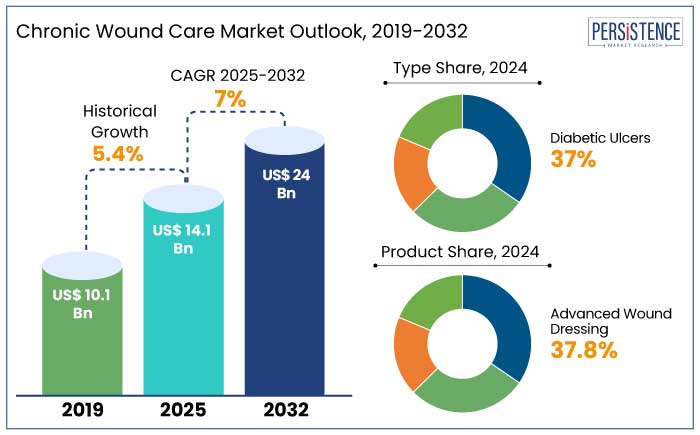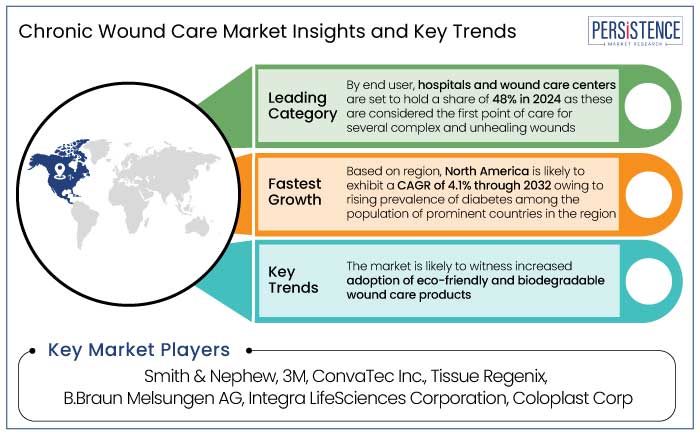ID: PMRREP33732| 191 Pages | 3 Jan 2025 | Format: PDF, Excel, PPT* | Healthcare

The global chronic wound care market is set to reach a size of US$ 14.1 Bn by 2025. It is anticipated to witness a CAGR of 7% during the forecast period to attain a value of US$ 24 Bn by 2032.
Innovations in the market like 3D-printed skin tissues and stem cell therapies are projected to gain traction during the assessment period. Integration with Artificial Intelligence (AI) is likely to enable predictive analytics for better patient outcomes.
Sensor-embedded dressings capable of monitoring wound healing in real time are projected to witness exponential growth. Portable devices for home healthcare are likely to dominate the global negative pressure wound therapy industry. A survey suggested that digital tools will contribute to a 20% reduction in wound-related hospitalizations by 2030.

Key Highlights of the Industry
|
Market Attributes |
Key Insights |
|
Chronic Wound Care Market Size (2025E) |
US$ 14.1 Bn |
|
Projected Market Value (2032F) |
US$ 24 Bn |
|
Global Market Growth Rate (CAGR 2025 to 2032) |
7% |
|
Historical Market Growth Rate (CAGR 2019 to 2023) |
5.4% |
North America is estimated to hold a share of 47% in 2024. The U.S. has a high prevalence of diabetes with 37.3 million people diagnosed as of 2022. Obesity rates in the country reached 41.9% in 2022, contributing to venous insufficiency and pressure ulcers.
North America accounts for over 40% of global spending on unique wound care products, including Negative Pressure Wound Therapy (NPWT), bioengineered skin substitutes, and antimicrobial dressings. The availability of favorable reimbursement policies for novel wound care products and treatments has been a significant growth driver.
Medicare and Medicaid in the U.S. cover a wide range of chronic wound care services, fueling growth. For example,
The U.S. accounts for 50% of global research and development spending on wound care technologies. Government programs and private companies collectively invested over US$ 1.5 Bn in 2022 in developing novel wound care solutions, including stem cell therapies and 3D-printed skin grafts.
Diabetic ulcers are predicted to hold a share of 37% in 2024. The aging population is susceptible to both diabetes and related complications, including Diabetic Foot Ulcers (DFUs). Sedentary lifestyles and unhealthy diets have contributed to the rising incidence of Type 2 diabetes, further driving the prevalence of DFU.
Preventive measures, such as regular foot examinations and early detection, have gained prominence in reducing DFU-related complications. Developed countries, including the U.S., have favorable reimbursement policies for DFU treatment, covering novel wound care products like negative pressure wound therapy and debridement procedures. In the U.S., 70% of DFU-related procedures are reimbursed, ensuring accessibility to unique treatments.
Advanced wound dressing is anticipated to hold a share of 37.8% in 2024. These wound dressings have gained prominence in the chronic wound care market owing to their superior healing outcomes.
Ability to address complex wound conditions and increased adoption across healthcare settings are also projected to bolster growth. Chronic wounds often require moisture management, infection control, and protection, which advanced wound dressings provide more effectively than traditional dressings.
Advanced dressings like hydrocolloids, hydrogels, and foam dressings maintain an optimal moist wound environment, accelerating healing by 40% to 50% compared to dry dressings. These dressings decrease the need for frequent changes, minimizing the risk of disruption to the healing process and improving patient comfort. Advanced wound dressings are versatile and suitable for various types of chronic wounds.
Hospitals and wound care centers are predicted to hold a share of 48% in 2024. They are the first point of care for complex and non-healing wounds that require specialized interventions.
They are equipped with state-of-the-art technologies and offer integrated care, including surgical debridement, advanced dressings, and diagnostic imaging for wound assessment. These centers bring together specialists, including dermatologists, vascular surgeons, podiatrists, and infectious disease experts, for holistic care.
Multidisciplinary approaches have resulted in improved healing rates by 30% to 40% compared to fragmented care. A significant number of chronic wound patients require hospitalization for complications like infections, gangrene, or delayed healing.
Hospitals are hence essential for managing severe or infected wounds requiring surgical intervention, intravenous antibiotics, or advanced therapies. The proliferation of dedicated wound care centers has enhanced access to specialized treatment.
Potential growth in the global chronic wound care industry is predicted to be driven by the adoption of telehealth in chronic wound care, thereby enabling remote consultations and monitoring. For example,
Government authorities in emerging countries like India and Brazil are progressively investing in subsidized wound care programs. Bioengineered skin substitutes are estimated to witness significant demand owing to their high effectiveness in treating complex wounds.

The chronic wound care market growth was decent at a CAGR of 5.4% during the historical period from 2019 to 2023. According to the International Diabetes Federation, the number of diabetic patients worldwide grew from 463 million in 2019 to 537 million in 2021. Diabetic foot ulcers affect 15% to 25% of diabetics during their lifetime, fueling demand for chronic wound care.
The elderly population increased by 10% globally between 2019 and 2023, with higher susceptibility to pressure ulcers and venous leg ulcers. Introduction of AI-driven wound management tools, bioengineered tissues, and smart dressings during the historical period enhanced wound care efficiency and outcomes.
The forecast period is estimated to witness rising adoption of dressings embedded with sensors for real-time monitoring. Increased demand for home-based care is further fostering innovations in portable negative pressure devices.
Surging Inclination toward Home Healthcare Services to Fuel Demand
Rising demand for home healthcare services is a significant trend in chronic wound care, driven by aging populations, cost pressures, and the desire for convenient and patient-centered care. Innovations in technology and treatment protocols enable patients to manage chronic wounds effectively at home. For example,
Home care minimizes exposure to pathogens prevalent in hospital settings, thereby decreasing the risk of infections.
Favorable Reimbursement Policies to Bolster Demand Worldwide
Policies are extending to include innovative technologies such as smart dressings and telemedicine services. Reimbursement is shifting toward outpatient wound care centers and home healthcare services to decrease hospitalization costs. Coverage for portable wound care devices further supports the trend toward decentralized care.
Policies now recognize the importance of preventive care, covering products like pressure-relief devices and monitoring tools to avoid complications. For example,
Reimbursement policies are critical for ensuring that patients can afford novel wound care technologies. For instance,
Use of telehealth for wound care is now reimbursed by Medicare, Medicaid, and most private insurers, especially after policy changes during the COVID-19 pandemic.
Lack of Awareness about Chronic Wounds to Hamper Growth in Rural Areas
Several patients lack knowledge about chronic wounds, their risks, and the importance of timely treatment. Delays in seeking medical attention for conditions like diabetic foot ulcers or pressure ulcers can lead to complications, such as infections or amputations. For instance,
Family caregivers often play a key role in wound care at home but may not receive adequate training. Lack of knowledge about proper wound cleaning, dressing changes, and infection prevention contributes to poor outcomes. For instance,
Inconsistent adherence to evidence-based guidelines for wound care, especially in rural and low-resource settings, exacerbates the problem.
Integration of Telemedicine and Digital Health Platforms to Create Prospects
Telemedicine and digital health technologies are transforming chronic wound care by improving patient outcomes, decreasing healthcare costs, and enhancing accessibility. For example,
Wearable sensors embedded in wound dressings can monitor parameters like moisture levels, pH, and temperature, thereby providing real-time feedback to healthcare providers. Cloud systems store patient data securely, enabling seamless sharing among healthcare teams. Integration with Electronic Health Records (EHRs) ensures comprehensive care coordination.
Rising Focus on Preventive Care to Open the Door to Success
Preventive care is a cornerstone of effective chronic wound management, aimed at decreasing the incidence, severity, and complications of wounds. For example,
Prevention decreases hospital stays, emergency room visits, and the need for surgical interventions such as amputations. For instance,
A hospital in the U.K. implemented a proactive pressure ulcer prevention program that reduced ulcer incidence by 65% within two years. A diabetes care clinic in India launched a foot care education campaign, decreasing foot ulcer incidence by 50% in three years.
Companies in the chronic wound care market are focusing on the development of new products like hydrocolloid dressings, bioengineered skin substitutes and antimicrobial dressings. They are progressively incorporating technologies like wearable sensors for wound monitoring along with AI-driven wound analysis.
Businesses are leveraging stem cell therapy and growth factors to promote faster and effective healing. They are collaborating with research institutions, healthcare providers, and technology companies to enhance research and development capabilities and drive innovation.
Companies are also partnering with distribution channels to extend their reach and improve product availability. They are ensuring compliance with local and international regulatory standards for gaining fast-track product approvals. Businesses are also engaging with regulators early in the product development cycle to streamline approval processes.
Recent Industry Developments
The market is anticipated to reach a value of US$ 24 Bn by 2032.
Diabetic ulcers, pressure ulcers, and venous ulcers are the three main types of chronic wounds.
Care of chronic wounds has become its own specialty with providers using unique therapies.
Prominent players in the market include Smith & Nephew, 3M, and ConvaTec Inc.
The market is predicted to witness a CAGR of 7% throughout the forecast period.
|
Attributes |
Detail |
|
Forecast Period |
2025 to 2032 |
|
Historical Data Available for |
2019 to 2023 |
|
Market Analysis |
US$ Billion for Value |
|
Key Regions Covered |
|
|
Key Market Segments Covered |
|
|
Key Companies Profiled in the Report |
|
|
Report Coverage |
|
|
Customization and Pricing |
Available upon request |
By Type
By Product
By End User
By Region
Delivery Timelines
For more information on this report and its delivery timelines please get in touch with our sales team.
About Author